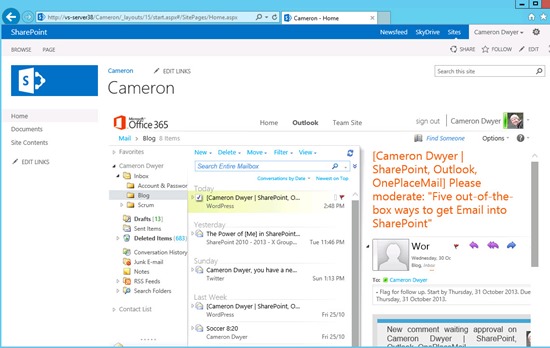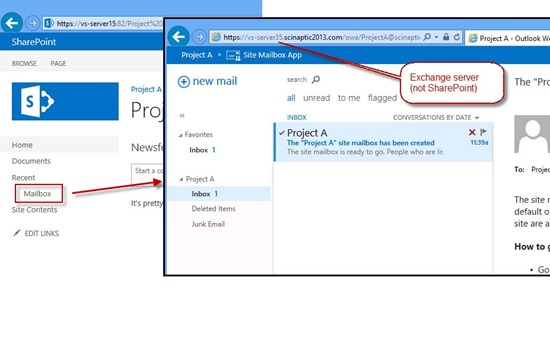SharePoint 2007 and SharePoint 2010 had a series of Web Parts dedicated to surfacing and interacting with an Exchange mail account directly from a page in SharePoint.
Overview of the Outlook Web Access Web Parts (for SharePoint 2007 and 2010)
If you are not familiar with the functionality here’s a quick overview (this info is taken from the official Microsoft help documentation http://office.microsoft.com/en-us/sharepoint-foundation-help/working-with-outlook-web-access-web-parts-HA101810215.aspx)
There are five Outlook Web Access Web Parts. These can be used with Microsoft Exchange Server version 2003 to 2007:
- My Calendar
- My Contacts
- My Tasks
- My Inbox
- My Mail Folder
These Web Parts are most useful for your My Site, because only you (or someone who can log into your Exchange e-mail account) will be able to see the information from your folders. If you put one of these Web Parts on a shared site, other users will see the Outlook Web Access logon screen in the Web Part.

Each Web Part displays the information from a folder in your email account, so you can choose the information you want to show on your site. The Web Parts make it easy to show specific information, such as tasks, without showing all of your Outlook information. If you want to have full Outlook functionality on your SharePoint site, you can use a Page View Web Part linked to the URL for your Outlook Web Access server.
All of the Outlook Web Access Web Parts provide two-way communication with your Exchange Server e-mail account: Changes you make in a Web Part appear in Outlook.
What’s the Story with OWA integration in SharePoint 2013?
I was somewhat surprised when SharePoint 2013 arrived and all the Outlook Web Access web parts were missing. Had this been an oversight by Microsoft and they would reappear again in a cumulative update for SharePoint? It appears not.
On further digging Microsoft actually dropped support for the OWA web parts (in SharePoint 2010) if your mail was hosted in Exchange Online (Office 365). From the Exchange Online Service Description document:
Exchange Online supports Outlook Web App Web Parts via the PageViewer control in Microsoft SharePoint Online and Microsoft SharePoint Server, or via manually configured URLs. Built-in SharePoint OWA Web Part controls will not work against Exchange Online
The statement above alludes to an alternate method using the Page Viewer control (which to be honest I’d prefer to the OWA web parts which didn’t have the full functionality of the OWA interface). The idea behind using the Page Viewer web part is that OWA is just a web interface to your Exchange account served up at known URLs. So just wrap these in a iframe (Page Viewer web part) and you will have your full OWA interface embedded inside a SharePoint page. For a step by step guide of how to setup the Page View control to connect to Exchange Online (OWA) take a look at this article by Jesper_Osgaard.
So fast forward to SharePoint 2013, can we still use the Page Viewer web part technique? My experience so far has yielded mixed results.
More often than not the Page Viewer technique gets tripped up with security issues. I think the underlying issue is that an Internet Explorer session cannot handle authenticating with multiple domains at the same time and it just so happens SharePoint Online and Exchange Online reside in different domains.
This isn’t to say it flat out doesn’t work. Here’s a screenshot to prove it (no smoke and mirrors or Photoshop involved I promise). But I just didn’t find it stable enough to recommend it as a viable solution.
On reflection it would seem that Microsoft wasn’t able to iron out the complexities of integrating OWA content and SharePoint content in the same Internet Explorer session. If they could, then surely that would have provided better integration for the native SharePoint Site Mailboxes that were introduced in SharePoint 2013 (Exchange 2013). When a SharePoint Site Mailbox is provisioned, a mailbox is created in Exchange (for the SharePoint site) and a link is placed on the left navigation of the SharePoint site. When you click on the link you don’t get the mailbox content embedded in the SharePoint page (as you might expect and have hoped for!). Instead it launches a new Internet Explorer window (new IE session that can authenticate with a different domain) and opens the OWA URL directly to the mailbox. There’s essential no integration with the SharePoint UI other than a URL link.


Reblogged this on Sutoprise Avenue, A SutoCom Source.
LikeLike
Hi
I just would like to let you know that you can have the outlook web parts
do below steps:
1) Go to Web part Gallery.
2) On Web part Gallery page, Click Files-> New Document -> New in the ribbon.
3) On New web part page(NewDWp.aspx), look for Microsoft.SharePoint.Portal.WebControls.OWAInboxPart , Select the web part and click on populate gallery.
Now, you can go to your SharePoint page where you want to add web part, click on Add web part. Under Miscellaneous Category, you will see OWAInbox web part.
Similarly, you can add OWA: Calendar, Task web parts etc.
reference:
http://social.technet.microsoft.com/Forums/sharepoint/it-IT/ecc5a39e-22f2-48ce-abfb-b34ef7c22e09/outlook-web-access-web-part-sharepoint-server-2013-was-deprecated?forum=sharepointcustomization
LikeLike
Thanks for posting this information Mohammad.
LikeLike
Hello Mohammad,
I was able to follow your post (comment) and get the OWAContactPart in my gallery and put it on my personal sharepoint page. But I am getting a 404 inside my OWAContactPart.
Is there a way you can help me configure correctly?
LikeLike
Assalamualaikum,
For sharing this info, Please, accept my sincere appreciation,
Regards
Abdul Hameed
LikeLike
Doesn’t work with latest patches and versions of Office 365 as they are sending X-Frame-Options setting as sameorigin in page headers, causing any solution utilizing iframe fail. This is a server side setting so it can’t be overridden if your Office 365 site is shared with other users. You can override this setting (which may not be aligned with your company security policy) if you have an on premises or exclusive online Office 35 server.
LikeLiked by 1 person
We have SharePoint 2013 On Prem and Exchange 2016 Online can we override these settings on SharePoint Server to display cal from exchange
LikeLike
Dear Cameron,
please, after using the owaInboxPart I have an error : This content cannot be displayed in a frame
do you have any idea
LikeLike
Hi Hassan. As I say in my article I couldn’t get the OWA inbox webpart to reliably work so I’m not surprised that you are having issues. For information on your specific issue however this may help:
http://msdynamicswiki.com/2011/09/04/error-message-when-you-view-an-outlook-web-app-web-part-in-a-sharepoint-online-site-in-office-365-this-content-cannot-be-displayed-in-a-frame/
LikeLike
What do you recommend me to retrieve the user inbox in MySites SharePoint 2013(on premise) knowing that I dont have Exchange administrator user ?
LikeLike
I don’t think there’s anything I can recommend, that was the findings presented in my article. I’m not sure if any of the technology has changed since I originally wrote it but I reached the frustrating conclusion that it just wasn’t possible to do it reliably. The only partial success I had was to use the Page Viewer web part to include OWA in an iFrame as presented in the article step by step guide of how to setup the Page View control to connect to Exchange Online (OWA) take a look at this article by Jesper_Osgaard. I still had issues with authentication and sometime it worked, sometimes it didn’t. THat’s the only direction I can point you in but as I say I didn’t find it reliable in my environment. Good luck.
LikeLike
Dear Cameron,
please, after using the owaInboxPart , How to bypass the authentication and open user inbox direct without entering username and password in sharepoint 2007 or any version ?
I want to open my Inbox in sharepoint without entering username and password
(I want to bypass entering of user information “username and password” as it is entered when I opened the Sharepoint site) for all the users.
LikeLike
Ensure the owa site is a trusted site in IE. Also ensure that the user has cached their credentials. You really need to get to the point that a user can go to the owa site directly in a browser and be logged in automatically. Then addressing via SharePoint should let the user to straight through. I always found that authentication and security issues plagued getting mail exposed on a SharePoint site. Now with Office 365 with a unified user identity across the SharePoint and Mail services the issue has largely been removed.
LikeLike
Cameron,
Excellent article. Very well organized content. Clean format.
I have a bit different scenario- We have an on premise SharePoint 2013 farm. I need to send a column value from a list form to Exchange 2010 public calendar using SharePoint 2010/2013 workflow.
I understand and am aware that public folders are going away but for now I do need to send list data to these Exchange 2010 public calendar.
Any suggestions?
LikeLike
If I understand you correctly you need to create a calendar entry in an Exchange public calendar from a SharePoint workflow. I assume you are able to get a handle on the SharePoint item in the workflow and read the required column values and the main issue is how to create the calendar entry? Unfortunately this is not something I’ve tried to do in the past. I’m not aware of a way to simply send something to an address that will have the item appear in the calendar (although it may be possible). In my experience you could achieve what you are after using Exchange Web Services (EWS). Your workflow would need to programmatically call EWS and create the calendar entry.
I hope this helps.
LikeLike
I believe I could create a custom SharePoint designer activity using Visual studio which will use EWS. The goal is to post vacation days from the vacation request form to department public folder calendar
LikeLiked by 1 person
Yes, that’s the approach I was thinking. Good luck.
LikeLike